For student journalists, reporting on schools can run afoul of administrations

When you think about impactful journalism, some images may come to mind — meeting sources in dark parking lots, going undercover to bust a scam ring, entering war zones. But those images are pretty far from the usual day to day work, which involves a lot of phone calls and unanswered emails and a whole lot of perseverance.
This story starts with a question: How does the school district balance the safety of students and the desire to take field trips during Covid?
That's what the staff at Inglemoor High School's student newspaper, the Nordic News, were looking into for a story last year.
Kellen Hoard was a co-editor of the Nordic News at the time. After contacting a school administrator for an interview, Hoard heard back from the then-communications director for the district. She said that all interview requests needed to go through her.
Eventually, the director barred teachers from speaking to student reporters.
This does happen in journalism. Press officers can be incredible resources, but sometimes they can also obstruct information.
Sponsored
Hoard and the staff at the Nordic News challenged the district's communications director in a months long process, both privately and in a public newspaper editorial, eventually regaining access to school staff.
Hoard, along with his co-editors, Mimi Avalos and Tammi Tran, recently accepted an award for courage in journalism from the Student Press Law Center for this fight.
"Courage in journalism isn't doesn't have to be actually putting yourself in harm's way it can be ensuring that others aren't experiencing that harm," Hoard said, "whether that's their harm to receive accurate information or to share their perspectives on their on their school or their workplace as a teacher or administrator."
According to the Student Press Law Center, student journalists run into issues like this all the time.
"If you're writing stories about sex, drugs and rock 'n'roll, you might get censored," said Mike Hiestand, senior legal council at the Student Press Law Center, "but by and large the number one reason that we're dealing with censorship is a story that, for whatever reason, the school thinks makes them look bad."
Sponsored
Hiestand regularly fields calls from student journalists as a part of his work at the law center.
The rights of student journalists stem from a 1988 Supreme Court Case called Hazelwood School District v. Kuhlmeier. In that case, an editor and reporter at a school newspaper filed a suit against the district after a principal removed articles about teen pregnancy and divorce from an issue of the school paper.
The court sided with the school district. Hiestand said the decision gave school officials more authority to censor school newspapers and speech.
"They said that school officials could censor speech, simply by declaring it 'poorly written' or 'biased or prejudiced,'" Hiestand said.
Since that 1988 decision, 16 states have passed New Voices Laws, sometimes refered to as anti-Hazelwood laws, which protect student journalists' work. Washington state passed a New Voices Law in 2018, more than a decade after the law was first introduced.





